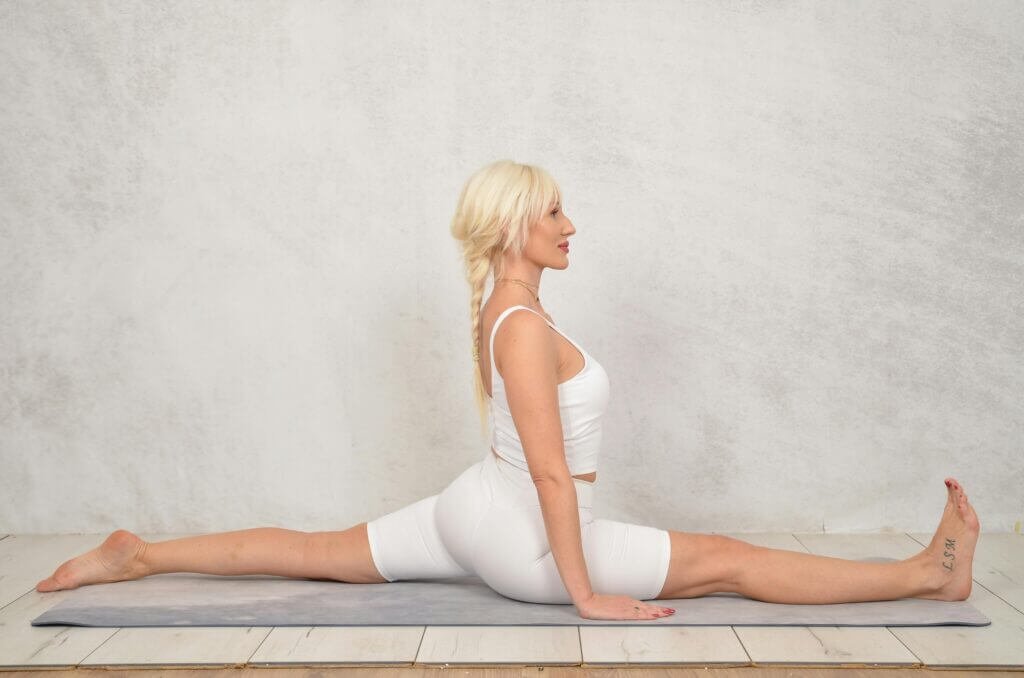Are you a baby boomer looking to stay fit and find your inner peace? Look no further than “Boomer Yoga”! This unique yoga practice is specifically designed to cater to the needs and abilities of the baby boomer generation. The gentle exercises and soothing meditation techniques will help you improve flexibility, strengthen your body, and calm your mind. Whether you’re a beginner or have previous experience, “Boomer Yoga” will provide a welcoming and inclusive space for you to explore the benefits of yoga. Get ready to embark on a journey of physical and mental well-being with “Boomer Yoga”!

Benefits of Boomer Yoga
Improves flexibility
One of the primary benefits of practicing yoga as a boomer is improved flexibility. As we age, our bodies naturally become less flexible, making everyday movements more challenging. Engaging in regular yoga practice helps to counteract this decline by stretching and lengthening the muscles, tendons, and ligaments throughout the body. By participating in yoga, you can regain and maintain flexibility, making daily activities easier and reducing the risk of stiffness and injury.
Increases strength
Maintaining strength is essential for boomer health, and yoga offers a low-impact and effective way to build and preserve muscle strength. Throughout yoga poses, your body weight is used as resistance, helping to tone and strengthen the muscles. Additionally, many yoga poses engage the core, improving stability and supporting the spine. By incorporating yoga into your routine, you can develop and maintain the strength necessary for a vibrant and active lifestyle.
Enhances balance
Another significant benefit of boomer yoga is that it enhances balance. As we age, we are more prone to balance-related issues, which can lead to falls and injuries. Yoga poses, such as tree pose and warrior III, challenge and improve balance by engaging the core and promoting body awareness. With consistent practice, not only will you find improved balance on the mat, but it will also translate into your daily life, reducing the risk of falls and helping you feel more confident in your movements.
Promotes relaxation
In our fast-paced and often stressful world, finding ways to relax and unwind is crucial. Boomer yoga offers a unique opportunity to cultivate relaxation through breath-focused movements and meditation. Yoga encourages deep breathing, which activates the parasympathetic nervous system, promoting a state of calm and relaxation. By incorporating regular yoga practice into your life, you can experience reduced stress and anxiety, improved mental well-being, and a greater overall sense of relaxation.
Getting Started with Boomer Yoga
Consulting a healthcare professional
Before embarking on any new fitness or wellness routine, it is essential to consult with a healthcare professional, especially if you have any pre-existing health conditions or concerns. They can assess your individual needs and provide guidance on how to safely incorporate boomer yoga into your lifestyle. They may also recommend modifications or specific practices depending on your health status. Taking the time to consult with a healthcare professional ensures that you approach yoga in a safe and personalized manner.
Finding a qualified instructor
When beginning your boomer yoga journey, it is crucial to find a qualified yoga instructor who specializes in teaching older adults or understands the specific needs and considerations of the boomer population. An experienced instructor will be able to guide you through proper alignment, modifications, and provide support tailored to your unique circumstances. Look for instructors with certifications from reputable yoga organizations and consider asking for recommendations from friends, family, or healthcare professionals.
Choosing the right yoga style
With the vast array of yoga styles available, it is important to choose one that aligns with your goals, preferences, and physical abilities. As a boomer, you may benefit from gentle or restorative styles of yoga that focus on flexibility, relaxation, and breath awareness. Hatha, yin, and chair yoga are excellent choices for beginners or those looking for a more gentle practice. Experiment with various styles to find the one that resonates with you and meets your individual needs.

Adapting Yoga Poses for Boomers
Modifying poses for joint health
As we age, joint health becomes even more crucial. To protect your joints during yoga practice, it is essential to modify poses to minimize strain and discomfort. This may involve using props, such as blocks or bolsters, to support and cushion joints, especially knees and wrists. Additionally, taking a wider stance or reducing the depth of a pose can help alleviate pressure on the joints. Listening to your body and respecting your limitations is key to adapting poses and ensuring a safe and sustainable yoga practice.
Using props for support
Props can be incredibly beneficial for boomer yogis, providing support, stability, and comfort during poses. Props such as blocks, straps, blankets, and bolsters can be used to modify poses, making them more accessible and allowing you to comfortably hold them for longer periods. For example, using a block under the hand in a standing forward fold can help bring the ground closer to you, allowing for a gentler stretch. Experiment with different props to find what works best for you and enhances your yoga practice.
Taking breaks and modifying intensity
Listening to your body and honoring its needs is crucial in a boomer yoga practice. It is perfectly acceptable to take breaks during a yoga session and modify the intensity of poses to fit your comfort level. If a pose becomes too challenging or uncomfortable, feel free to rest in child’s pose or another resting position until you feel ready to continue. Remember that yoga is a personal journey, and the only competition is with yourself. Embrace modifications and variations that suit your body’s unique needs and capabilities.
Boomer-Specific Yoga Practices
Gentle yoga sequences
Gentle yoga sequences are an excellent choice for boomers, as they prioritize slow, mindful movements that promote relaxation and flexibility. These sequences typically incorporate a combination of standing, seated, and reclining poses, focusing on proper alignment and breath awareness. Gentle yoga sequences offer a gentle yet effective way to improve overall strength, flexibility, and balance without putting excessive stress on the body. They are perfect for beginners or those with physical limitations who want to experience the benefits of yoga in a safe and accessible manner.
Chair yoga
Chair yoga is a wonderful option for boomers who may have difficulty with mobility or standing for extended periods. As the name suggests, chair yoga involves performing yoga poses predominantly while seated in a chair, making it accessible for individuals with limited mobility, balance issues, or who prefer added support. Chair yoga offers all the benefits of a traditional yoga practice, including increased flexibility, strength, and relaxation, but adapts the movements to accommodate different physical abilities. It is an inclusive and enjoyable way to experience the joys of yoga.
Yin yoga
Yin yoga is a slow-paced style that targets the deep connective tissues, such as the fascia, ligaments, and joints. It involves holding poses for more extended periods, typically three to five minutes, allowing the body to relax and release tension deeply. Yin yoga can be highly beneficial for boomers, as it encourages flexibility and improves joint health. The extended holds also offer an opportunity for introspection and mindfulness, making it a holistic practice for both the body and mind. Incorporating yin yoga into your routine can complement other physical activities and promote overall well-being.

Yoga for Common Boomer Health Concerns
Arthritis and joint pain
Arthritis and joint pain are common challenges that many boomers face. Fortunately, yoga can be a valuable tool for managing and reducing discomfort associated with these conditions. Gentle yoga sequences, such as those incorporating slow and controlled movements, can help improve joint flexibility while minimizing strain. Additionally, practicing poses that focus on strengthening the muscles surrounding the joints can provide added stability and reduce pain. It is important to listen to your body, adapt poses accordingly, and work closely with a healthcare professional to tailor your yoga practice to your specific needs.
Osteoporosis
Osteoporosis, characterized by decreased bone density, can increase the risk of fractures and impact daily activities. Yoga can be a beneficial practice for individuals with osteoporosis as it promotes posture, balance, and gentle weight-bearing movements that improve bone health. Poses such as downward-facing dog and tree pose encourage weight-bearing through the arms and legs, supporting bone mineral density. However, it is essential to practice yoga under the guidance of a qualified instructor who can provide modifications and ensure proper alignment to avoid excessive stress on the bones.
Heart health
Maintaining a healthy heart is crucial for boomer wellness, and yoga can be a valuable tool in promoting cardiovascular health. While not an intense aerobic exercise, yoga’s mindful movements, deep breathing, and stress reduction qualities contribute to heart health. By practicing yoga, you can lower blood pressure, reduce stress and anxiety, and improve overall circulation. Poses that gently open the chest, such as cobra or bridge pose, can also be beneficial for heart health. Remember to listen to your body and avoid overexertion, especially if you have any pre-existing heart conditions.
Precautions and Safety Tips
Avoiding overexertion
When engaging in boomer yoga, it is important to prioritize safety and avoid overexerting yourself. Take breaks as needed, modify poses when necessary, and listen to your body’s signals. Pushing yourself too far can lead to strain, injury, or exacerbation of existing health conditions. Remember that yoga is not about achieving the most advanced poses, but rather about honoring your body’s limitations and finding balance in your practice.
Using proper alignment
Proper alignment is crucial in boomer yoga to prevent injury and maximize the benefits of each pose. Focus on aligning your joints, engaging your core, and maintaining a neutral spine throughout your practice. A qualified instructor can provide guidance on proper alignment and adjustments tailored to your body’s needs. Paying attention to alignment not only supports your physical safety but also enhances the efficacy and effectiveness of your yoga practice.
Monitoring breath and energy levels
Breath awareness is a fundamental aspect of yoga and can serve as a valuable guide during your practice. Pay attention to your breath, ensuring that it remains steady and even throughout each pose. If you find yourself struggling to maintain a steady breath or your energy levels feel depleted, it may be a sign to take a break or modify the intensity of your practice. Always prioritize self-care and listen to your body’s needs for rest and replenishment.

Creating a Safe and Supportive Yoga Space
Choosing comfortable attire
When practicing boomer yoga, wearing comfortable and breathable attire can greatly enhance your experience. Opt for loose-fitting clothing that allows for a full range of motion and moisture-wicking fabrics to keep you dry and comfortable during your practice. Choose materials that are gentle on the skin and avoid clothing with restrictive waistbands or constrictive features that could impact your ability to move freely.
Using non-slip mats or props
To create a safe yoga space, invest in a non-slip mat or use props such as blankets or yoga blocks to provide stability and prevent slips or falls during your practice. Non-slip mats offer traction and grip, ensuring that you can maintain proper alignment and stability throughout your poses. If you have hardwood or tiled floors, consider placing your mat on a non-slip mat or using additional props for added support and safety.
Maintaining a clutter-free area
Clearing your yoga space of clutter and distractions is essential for creating a safe and focused environment. Remove any obstacles or tripping hazards from your practice area and ensure that it is a dedicated space where you can fully concentrate on your yoga practice. Creating a clutter-free zone promotes a sense of serenity and allows you to fully immerse yourself in the present moment during your practice.
The Role of Mindfulness in Boomer Yoga
Cultivating body awareness
Mindfulness is a core component of boomer yoga, as it encourages the cultivation of body awareness. By practicing yoga mindfully, you learn to listen to your body’s signals, recognize areas of tension or discomfort, and make adjustments accordingly. Cultivating body awareness allows you to adapt poses, modify intensity, and practice with greater intention, ultimately enhancing the overall benefits of your yoga practice. Mindful movement fosters a deeper connection between your mind and body, promoting clarity, relaxation, and self-awareness.
Focusing on the present moment
Boomer yoga provides a valuable opportunity to escape the distractions and demands of daily life and bring your full attention to the present moment. As you move through yoga poses and pay attention to your breath, you learn to let go of worries, thoughts, and external pressures. Focusing on the present moment cultivates mindfulness and a sense of calm, allowing you to experience the full benefits of each pose and find refuge from the busyness of everyday life.
Practicing mindfulness during meditation
In addition to mindful movement, boomer yoga often incorporates meditation or mindfulness practices. Taking time to sit in quiet reflection, focus on the breath, or engage in guided meditation can further deepen your yoga experience. Regular meditation practice helps to reduce stress, promote mental clarity, and nurture a sense of inner peace. By incorporating mindfulness into your boomer yoga routine, you create space for personal growth, self-reflection, and emotional well-being.

Benefits of a Regular Boomer Yoga Practice
Reduced stress and anxiety
One of the significant benefits of a regular boomer yoga practice is a reduction in stress and anxiety levels. The combination of mindful movements, breath awareness, and relaxation techniques incorporated in yoga helps activate the parasympathetic nervous system, triggering the body’s natural relaxation response. By consistently practicing yoga, you can experience a greater sense of calm, improved mood, and reduced feelings of stress and anxiety, promoting overall mental well-being.
Improved sleep quality
Boomer yoga can also positively impact the quality of your sleep. The relaxation techniques and breathwork practiced during yoga can help calm the nervous system, preparing both the body and mind for a more restful night’s sleep. Engaging in yoga before bedtime can promote relaxation, reduce racing thoughts, and ease physical tension, all of which contribute to improved sleep quality. By incorporating boomer yoga into your evening routine, you can set the stage for a peaceful and rejuvenating sleep.
Increased body confidence
A regular boomer yoga practice can help increase body confidence by fostering a greater connection between the mind and body. As you engage in mindful movements, build strength, and improve flexibility, you develop a deeper appreciation for your body’s capabilities and resilience. Yoga is a non-judgmental practice that encourages self-acceptance, body positivity, and self-love. By embracing your yoga practice as a personal journey, you can cultivate a positive body image and increased confidence in your physical abilities.
Embracing Yoga as a Lifelong Practice
Making yoga a regular part of daily routine
To fully embrace yoga as a lifelong practice, it is essential to make it a regular part of your daily routine. Aim to dedicate a specific time each day to engage in your yoga practice, whether it’s in the morning, during lunch breaks, or in the evening. Consistency is key when it comes to reaping the benefits of yoga, so establishing a regular routine helps make it a natural and integrated part of your lifestyle. By prioritizing yoga in your daily schedule, you set yourself up for long-term success and well-being.
Adapting practice as needs change with age
As we age, our bodies naturally change, and it is important to adapt your yoga practice accordingly. Be mindful of any physical limitations or changes that arise and embrace modifications or alternative poses that suit your needs. Additionally, consult with your healthcare professional and yoga instructor regularly to ensure that your practice evolves with your changing needs. Adapting your practice as you age allows you to continue reaping the benefits of yoga while respecting your body’s unique requirements and limitations.
Connecting with a supportive yoga community
Embracing yoga as a lifelong practice is enhanced by connecting with a supportive yoga community. Seek out local classes, workshops, or online communities that cater to boomers and provide a supportive and encouraging environment. Engaging with like-minded individuals who share your passion for yoga can offer motivation, inspiration, and a sense of belonging. A strong community can provide support during challenging times, celebrate your progress, and keep you committed to your lifelong yoga journey.
In conclusion, boomer yoga offers a wide range of benefits that encompass physical, mental, and emotional well-being. Through improved flexibility, increased strength, enhanced balance, and relaxation, boomers can enjoy a better quality of life and vitality. By following the guidelines for getting started, adapting poses, and exploring boomer-specific yoga practices, individuals can personalize their practice and address common health concerns. Practicing boomer yoga with precautions, creating a safe and supportive space, and incorporating mindfulness enhances the overall experience. The regular practice of boomer yoga offers reduced stress, improved sleep, and increased body confidence. Embracing yoga as a lifelong practice involves making it a regular part of daily routine, adapting to changing needs with age, and connecting with a supportive community. So, grab your mat, breathe deeply, and embark on a rejuvenating and transformative boomer yoga journey.


